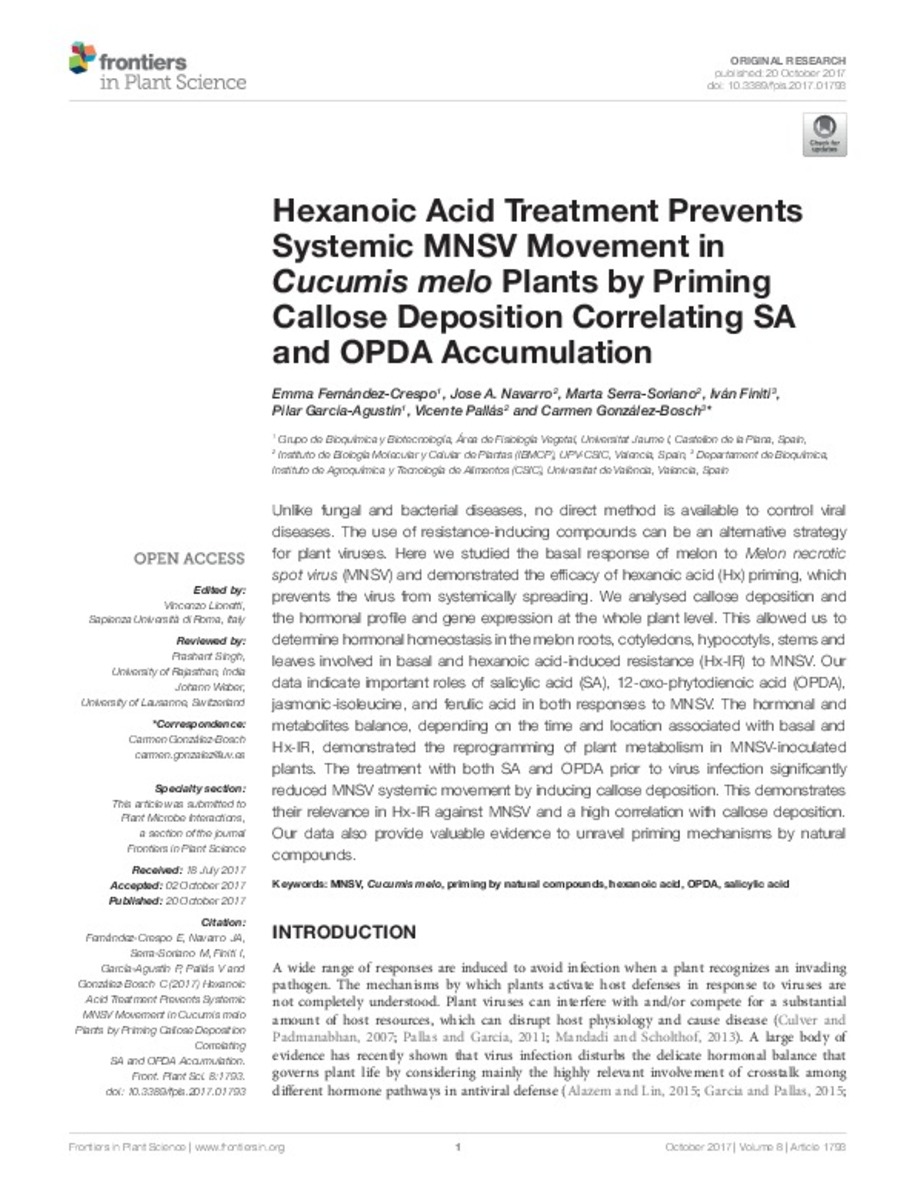Mostrar el registro sencillo del ítem
Hexanoic Acid Treatment Prevents Systemic MNSV Movement in Cucumis melo Plants by Priming Callose Deposition Correlating SA and OPDA Accumulation
| dc.contributor.author | Fernández Crespo, Emma | |
| dc.contributor.author | Navarro, José A. | |
| dc.contributor.author | Serra Soriano, Marta | |
| dc.contributor.author | Finiti, Iván | |
| dc.contributor.author | García Agustín, Pilar | |
| dc.contributor.author | Pallàs, Vicente | |
| dc.contributor.author | González-Bosch, Carmen | |
| dc.date.accessioned | 2017-12-18T10:24:49Z | |
| dc.date.available | 2017-12-18T10:24:49Z | |
| dc.date.issued | 2017-10-20 | |
| dc.identifier.citation | FERNÁNDEZ CRESPO, Emma; NAVARRO, José A.; SERRA SORIANO, Marta; FINITI, Iván; GARCÍA AGUSTÍN, Pilar; PALLÀS, Vicent; GONZÁLEZ-BOSCH, Carmen. Hexanoic Acid Treatment Prevents Systemic MNSV Movement in Cucumis melo Plants by Priming Callose Deposition Correlating SA and OPDA Accumulation. Frontiers in Plant Science (2017), v. 8, online | ca_CA |
| dc.identifier.uri | http://hdl.handle.net/10234/171103 | |
| dc.description.abstract | Unlike fungal and bacterial diseases, no direct method is available to control viral diseases. The use of resistance-inducing compounds can be an alternative strategy for plant viruses. Here we studied the basal response of melon to Melon necrotic spot virus (MNSV) and demonstrated the efficacy of hexanoic acid (Hx) priming, which prevents the virus from systemically spreading. We analysed callose deposition and the hormonal profile and gene expression at the whole plant level. This allowed us to determine hormonal homeostasis in the melon roots, cotyledons, hypocotyls, stems and leaves involved in basal and hexanoic acid-induced resistance (Hx-IR) to MNSV. Our data indicate important roles of salicylic acid (SA), 12-oxo-phytodienoic acid (OPDA), jasmonic-isoleucine, and ferulic acid in both responses to MNSV. The hormonal and metabolites balance, depending on the time and location associated with basal and Hx-IR, demonstrated the reprogramming of plant metabolism in MNSV-inoculated plants. The treatment with both SA and OPDA prior to virus infection significantly reduced MNSV systemic movement by inducing callose deposition. This demonstrates their relevance in Hx-IR against MNSV and a high correlation with callose deposition. Our data also provide valuable evidence to unravel priming mechanisms by natural compounds. | ca_CA |
| dc.format.extent | 15 p. | ca_CA |
| dc.format.mimetype | application/pdf | ca_CA |
| dc.language.iso | eng | ca_CA |
| dc.publisher | Frontiers Media | ca_CA |
| dc.relation.isPartOf | Frontiers in Plant Science (2014), v. 8 | ca_CA |
| dc.rights | Atribución 4.0 Internacional | * |
| dc.rights.uri | http://creativecommons.org/licenses/by-sa/4.0/ | * |
| dc.subject | MNSV | ca_CA |
| dc.subject | Cucumis melo | ca_CA |
| dc.subject | Priming by natural compounds | ca_CA |
| dc.subject | Hexanoic acid | ca_CA |
| dc.subject | OPDA | ca_CA |
| dc.subject | Salicylic acid | ca_CA |
| dc.title | Hexanoic Acid Treatment Prevents Systemic MNSV Movement in Cucumis melo Plants by Priming Callose Deposition Correlating SA and OPDA Accumulation | ca_CA |
| dc.type | info:eu-repo/semantics/article | ca_CA |
| dc.identifier.doi | https://doi.org/10.3389/fpls.2017.01793 | |
| dc.relation.projectID | Spanish Ministry of Science and Innovation (AGL2010-22300-C03-01-02, AGL2013-49023-C03-01-02-R and BIO2014-54862-R), co-funded by the European Regional Development Fund | ca_CA |
| dc.rights.accessRights | info:eu-repo/semantics/openAccess | ca_CA |
| dc.relation.publisherVersion | https://www.frontiersin.org/articles/10.3389/fpls.2017.01793/full | ca_CA |
| dc.type.version | info:eu-repo/semantics/publishedVersion | ca_CA |
Ficheros en el ítem
Este ítem aparece en la(s) siguiente(s) colección(ones)
-
CAMN_Articles [566]








